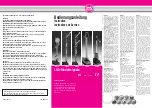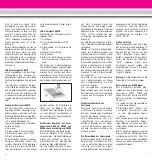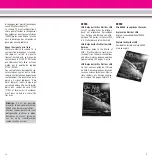
11
10
tary switch with two screws in the
slotted holes pre-drilled in the tie.
Then the signal mast is fixed onto the
drive. In doing so, the electrical con-
nection for the illuminated signal
lamp ist established at the same
time. While fixing the signal one
must make sure that the fork of the
guide lever on the socket of the mast
interlocks with the control slide of
the drive.
Now you should install the second
insulated track section. The distance
to the signal should be the minimum
distance that allows the most power-
ful locomotive at its fastest speed to
come to a halt before reaching the
home signal (L2 illustration 9).
The insulated track sections must be
installed so that both insulated rails
lie on the same side of the track. The
cable connection of the power supply
must be put on such that the nega-
tive rail is powered when the speed
control knob is turned clockwise.
LGB Form Distant Signal 50910
The train operator knows a distant
signal is approaching by the signal
warning sign. It allows him to antici-
pate the position of the following
home signal. “Stop Signal Ahead!“ is
signified by the vertical position of
the round signal disk and the yellow
signal light. “Proceed Signal Ahead“
is indicated by the horizontal position
of the signal disk and a green signal
light.
Installation of Distant Signal 50910
This distant signal should be careful-
ly installed at least one train length
before the home signal. Because
model railways are usually not long
enough to accomodate prototypical
distant signal distances, you may
have to depart from building exactly
to prototype in this case and com-
promise if possible. In the distant
signal package, you’ll find the follow-
ing pieces:
a) Distant signal
b) One half straight track section
(LGB No. 10150)
c) Three signal warning signsAt the
position of the section where the
distant signal is placed, install the
No. 10150 track piece and attach
the signal drive. Complete the
installation by inserting the signal
in the drive’s socket.
LGB Light Signal 50950
The LGB Light Signal is packaged
together with the following pieces:
1) Light Signal
2) Two insulated track sections
3) EPL signal drive with supple-men-
tary switch
4) Activating magnet in plastic clip
5) One diode
6) Cable to connect 1203 with 10153
(1015U)
I
nstallation of LGB Light Signal
50950
Install the insulated track section and
the assembly of the switchdrive with
supplementary switch on the track
the same way you would for an LGB
form signal. For the light signal, the
small plastic clip must be affixed to
the lever of the signal drive. In the
plastic clip is a magnet, which caus-
es the signal light to change from red
to green. Finally, the light signal
should be inserted into the socket.
Electrical Connection of the Form
Home Signals 50920, 50940 and
50960 and the Light Signal 50950
Signal positions can be controlled by
depressing a switch on the LGB
Momentary Switch Control Box
51750 (50750). The wire connection
from the switch control box to the
connection clips activates the signal
drive under the signal (Illustration 9).
To control one train, that is, to make
one train come to a halt before the
“Stop!“ signal, some additional wire
connections are necessary. A 6-pole
connecting block is concealed under
the covering of the insulated track
section 1015U (as shown in illustra-
tion 6).:
To simplify the wiring process, there
are duplicate negative connections.
Illustration 7 shows the wire connec-
tions from the insulated track section
to the signal drive with supplemen-
tary switch 12030, whereby the wire
must be attached to clips 2A and 2B
in the insulated track section.
The connection clips then connect to
the supplementary switch. By doing
this, the supply of power also flows
to clips 1A and 2B. Additionally, a
cable connection must be estab-
lished from the insulated track sec-
tion on the signal to the insulated
track section in front of the signal.
The various cable connections nec-
essary to link form home and form
distant signals are seen in Illustation
8 and 9.
Electrical Connection of the
Distant SignalsDistant signals have
no ability to control trains. They work
in combination with the home signal.
For this reason, only one cable con-
nection from the distant signal drive
to the home signal drive is neces-
sary, which should be attached to the
home signal clips leading to the
switch control box.
Lighting the Form Signals
The signal light is attached to both
the clips, which are arranged to the
side of the signal drive directly
behind the signal mast. When you
use several signals, you should use
an additional transformer to supply
power to them (such as LGB’s No.
50060). This will help the main trans-
former supply power to your trains
more efficiently.
Installation of the Diode
The diode that comes with every
home signal, can be installed as
shown in illustration 13. The diode’s
installation means that a train will
remain standing in front of a signal
showing “Stop!“ Opposing traffic,
however, can pass without a forced
stop at a signal showing “Stop!“
after the installation of the diode.
In case of using our multitrain sys-
tem, it is vitally important to remove
the diodes. Otherwise an automatic
train stop will not be possible.
Attention!
For digital operation, the
diode (Fig. 13a) must be removed.
Replacing the Light Bulb
To replace a defective light bulb in
the signal light of form signals
50920, 50940 and 50960 (as well as
in distant signal 50910), use the fol-
lowing procedure (shown in illustra-
tions 10 and 11):
1) Remove the cover of the signal
disk frame.
2) Push plug-in light bulb 68501
(5050/1) down and out of the sig-
nal light and replace it by pushing
the new light bulb up.
Never attempt to extract a light bulb
downward by pulling on the wiring.
Illustration 12 shows how to replace
the light bulbs for main light signal
50950.
After removal of the front panel, the
bulbs can be easily unscrewed.


























